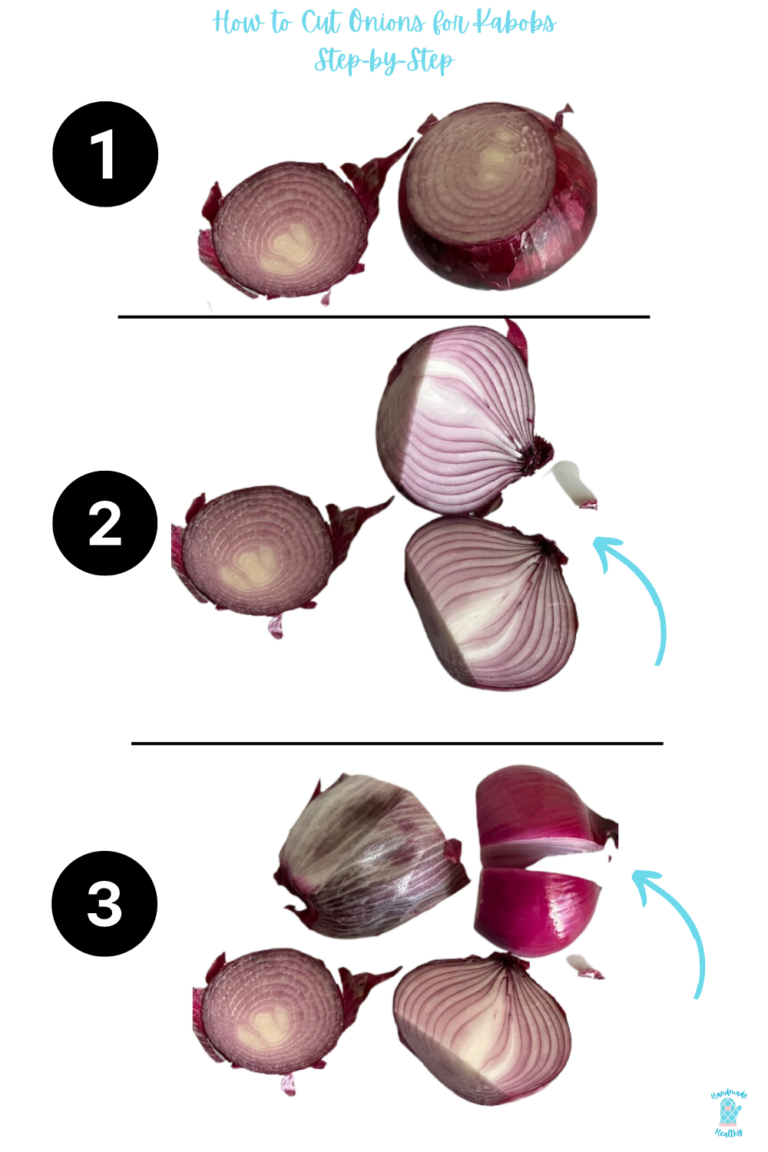Easy Tips How to Cut Onions for Kabobs Step-by-Step
When it comes to kabobs, knowing how to cut onions for kabobs is essential.
With these easy tips and step by step instructions, you will be a pro at cutting onions for kabobs.
There are several types of onions that can be used for kabobs. But let’s first define what kind of kabob you are looking to add into culinary endeavors.
What is a Kabob?
A simple way to describe the typical kabob, is adding meat and/or vegetables to metal skewers or wooden skewers. Many people add these to a grill or barbecue pit to cook with a smoky flavor. However, kabobs can also be baked in an oven or cooked in an air fryer.
There are many types of kabobs that you can make including chicken kabobs, beef or pork kabobs, or vegetable kabob skewers. Some people call them shish kabobs which is the full name for the kabob.

Types of Onions for Kabobs
There are several types of kabobs of onions that can be a part of delicious kabobs.
First, let’s start with the most colorful onion, the red onion. Red onions, or purple onions, add a nice color to the skewer which can really bring out the color and flavor of the other ingredients in the kabob recipes.
Next, the sweet onions and yellow onions are one of the more common onions found on veggie kabobs. Yellow sweet onions are very versatile and can be used in a number of dishes. You might also find a Texas sweet onion as another type of sweet onion as well.
Finally, classic white onions is another onion that ideal for vegetable kabobs or any type of kabob. The white onion pairs well with most meats and also other aromatic vegetables.

How to Cut Onions for Kabobs: The Step-by-Step Process
Follow these easy steps for cutting onions and you will be ready to cook kabobs in no time!
A good rule of thumb when learning how to cut onions for kabobs is to identify the stem end of the onion versus the root end of the onion.
The stem side of the onion has a stem piece on it. Whereas the root end of the onion has tiny root hairs coming from it.
Be sure to have a good sharp knife for slicing. In addition, a good cutting board is also important when doing any type of cutting.

Follow these steps to cut the onions for kabobs. See pictures for step-by-step diagram.
Step 1
Begin by cutting the stem side of the onion off.
Step 2
Next, cut the onion lengthwise to toward the root side of the onion. You will then have 2 halves.
Peel the outer layer of the onion.
Step 3
Slice one half of the onion down and slice one more time into a quarter piece.

Step 4
Once the onion is sliced into a quarter piece, you can then take apart the layers.
Step 5
The sliced onions are now ready for your skewer.
It’s important to remember, the slices don’t have to be perfect. However, try to get them in similar size pieces so that they can cook more evenly.
Vegetables to Add to Kabobs
There are several other vegetables that you may enjoy adding to a kabob. Fresh cherry tomatoes and sliced green peppers, like bell peppers, are delicious on a kabob. Additionally, corn, mushrooms, zucchini, and squash are delicious on a kabob. Sometimes you can find a small onion that you don’t need to slice such as a pearl onion to go on the kabob as well.
Here is a list of vegetables that work well for kabobs:
Large Cherry Tomatoes
Green, Yellow, or Red Bell Peppers
Corn Slices
Mushrooms
Zucchini Slices
Squash Slices
Pearl Onions
Most importantly, it is great to add vegetables with your kabobs to create a flavorful balance to the meal.
Protein to Add to a Kabob
When choosing protein for kabobs, the most important thing to do is make sure that the pieces are evenly cut. Having the protein evenly cut will help with making sure that the meat is cooked evenly.
In addition, marinating the meat/protein will help with the moisture and tenderness of the meat during the kabob cooking process.
Here are protein ideas for kabobs:
Sirloin Tips
Strip Steak
Chicken (thighs or breast)
Pork (lean whole cuts of pork)
Shrimp (large size)
As mentioned earlier, be sure to have a good food thermometer on hand to prevent under cooking or over cooking your protein sources.
The Best Way to Cook a Kabob
You will want to coat the kabob with oil such as olive oil or avocado oil. This will help you can get some nice, caramelized onions on the kabob.
Grilling tends to be the most common way to cook kabobs. One suggestion if you are grilling kabobs is to marinate the meat items beforehand. This is especially helpful when using lean cuts that may tend to dry out during the grilling process. Marinated chicken, beef, or pork will have such a great flavor after grilling them.
If you do not have a grill, place the kabobs on a baking sheet in the oven and bake them.
In addition, a good food thermometer is important when cooking kabobs. If you have meat protein on your kabob, you will want to be sure to make sure that the meat is cooked to the appropriate temperature. You can find the proper temperatures listed here.
Checking food temperatures when cooking is also helpful in not overcooking the meat as well.
Side Dishes Served with Kabobs
Kabobs make a great dish on their own, however, they are perfectly paired with so many other foods as well. Since most kabobs have meat and vegetables, they pair well with a filling carboydrate food. For example, rice and pasta pair great with kabobs. Mashed potatoes or baked potatoes can all be a nice pairing especially with the barbecue and grilling flavors.

Examples of Types of Kabobs
Learning how to slice onions for kabobs comes in handy for making many different types of kabobs. Below we have listed 4 types of kabobs that are commonly found on the grill.
1. Traditional Beef and Vegetable Kabob
2. Seafood and Vegetable Kabob
3. Vegetables and Chicken Kabob
4. Chicken, Pineapple, and Vegetable Kabob
Keep in mind that there are many different types of kabobs that you can make. There are even kabobs that don’t have to be cooked like a “Caprese Kabob.” Many people love to add fruit to kabobs whether it is on the grill or off the grill. For example, mango chunks are great on a kabob.
Easy Tips for Cutting Vegetables for Kabobs
1. Choose a variety of colors of vegetables.
The variety of colors will not only make your kabobs look more tasty, but also will add more depth of flavor and nutrition. One of the best tips without spending a lot of extra money is to add different onion colors and peppers.
2. Be sure to cut all of the vegetables to around the same size.
Of all of the tips, this one is the most important in making successful kabobs. By cutting the vegetables to the same size, the cooking time will be more accurate. If vegetables are cut to a variety of sizes, they will have a tendency to cook unevenly.
3. Marinate the vegetables and the meat.
Blending the vegetables in with the meat marinade will not only season the vegetables, but this combination will also give flavor to the meat. Just remember, do not eat the vegetables after mixing them with raw meat. You will have to wait until they are fully cooked – sorry, I know it’s tempting.
4. Soak the skewer in water.
This is one step that is for the wise. Soaking the skewer in water will help retain moisture in the wooden skewer while cooking. Skip this tip if you are using metal skewers.
5. Use kabobs to help clean out the refrigerator.
Kabobs are great for making good use of older vegetables. That’s the good thing about cooking vegetables… after they are cooked they look the same whether they are fresh bought or have been in the refrigerator for a week or two.
6. After you cook and eat, save the vegetables to add to other meals.
Grilled vegetables from kabobs are perfect for making tacos, adding to sandwiches, and even adding to a stir-fry.


















